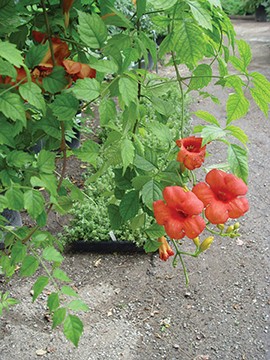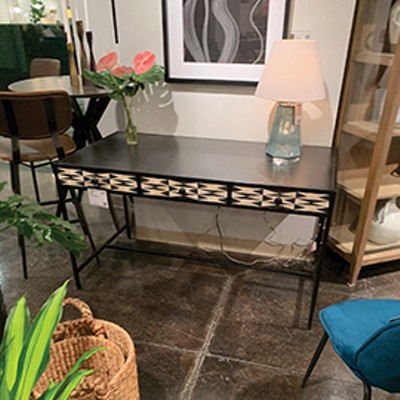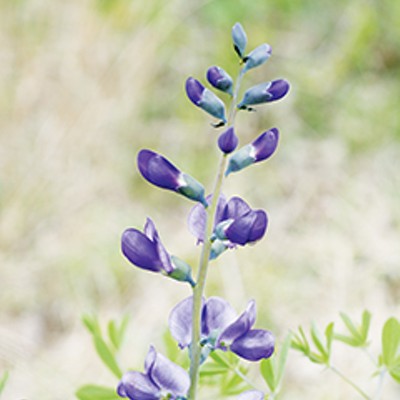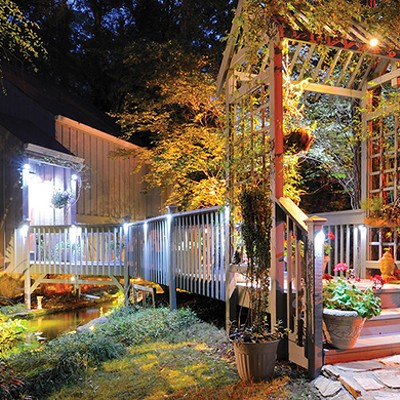How to get started with vines
[
{
"name": "Air - MedRect Combo - Inline Content 1",
"component": "11490391",
"insertPoint": "3",
"requiredCountToDisplay": "1",
"parentWrapperClass": "fdn-ads-inline-content-block"
},{
"name": "Air - MedRect Combo - Inline Content 2",
"component": "11490392",
"insertPoint": "7",
"requiredCountToDisplay": "5",
"parentWrapperClass": "fdn-ads-inline-content-block"
},{
"name": "Air - MedRect Combo - Inline Content 3",
"component": "11490393",
"insertPoint": "12",
"requiredCountToDisplay": "9",
"parentWrapperClass": "fdn-ads-inline-content-block"
}
]
Trumpet creeper is so large, so willing and so floriferous, it was a favorite outhouse cover-up. Only a reliable plant could survive on these neglected spaces, visited only when necessary. All summer long that vine bloomed on very fertile ground, spreading into a privacy barrier that hummingbirds flock to.
Pioneers planted cuttings from outhouse vines onto slash piles and rubbish heaps to screen them from view. The plant Campsis radicans thrives in areas of summer rainfall like its homeland, the American Southeast.
Cover your well house with red trumpet flowers. Turn your wire fence into a floral partition. Create shade over your arbor with luxuriant, fast growth. These are just a few reasons why Campsis radicans is a useful vine that offers an alternative to short-flowering wisteria. Because it’s a Southeastern native, this plant is well adapted to a huge range of conditions from extreme heat to chilly Zone 4. Best of all, it is deer-resistant, making Campsis radicans the ideal western vine for rural and suburban areas.
The deciduous trumpet creeper vine loves summer rain and will potentially be invasive where conditions are similar to its homeland. It naturalizes in the Midwest. They climb by holdfasts into trees and structures, root easily where there is soil contact and seeds are prolific. Long, rainless summers keep it in check, however. It’s just too dry in most places for this vine to spread by root or seed beyond limits of spot irrigation.
The native can grow from 25 to 40 feet. It flowers on new growth and is coveted by ruby-throated hummingbirds. They are sun lovers and may be disappointing bloomers in too much shade. In recent years superior plants have appeared serendipitously in gardens and nurseries. One recent discovery in a California beach town featured more yellow-orange flowers. It was developed by Monrovia, considered superior to the species, and sold as Campsis radicans ‘Monbal.’
Another earlier variation upon this species was a grand hybrid cross between Campsis radicans and its Chinese cousin, Campsis grandiflora. The goal was to obtain the larger flowers of grandiflora and hopefully lose the clinging roots of radicans, on a cold-hardy plant.
It is important to know these differences in the trumpet creepers sold today. The more brutal the conditions, the better chance you’ll have planting the species from seed, cutting or nursery. It’s got all those primal native adaptations in its gene pool that survive outhouse conditions as well as weather extremes, anomalies and unusual climatic events. The climbing holdfasts also are essential if you want to cover structures so the vine can attach for wind protection.
In most rural or suburban residential settings, clinging vines of any kind are avoided due to the potential for structural damage. Here it is better to choose ‘Madame Galen’ to ensure you won’t have to worry about aerial roots. Use this plant for entry posts and arches, decorative trellises and anywhere else you need big color. Most flowering plants slow or stop blooming in August heat, but with trumpet creeper in the garden you won’t go without.
Even in its native territory, nothing much eats this vine. An old name, cow-itch, refers to the effect of skin contact with the foliage. Sensitive folks should wear gloves. This odd toxicity is what made Campsis radicans so popular as a fence vine because it isn’t decimated by deer. It is wise to keep all vines clear of pets and livestock pens.
Because these flowers are such wildlife draws, you’ll want them close to windows and outdoor living spaces to enjoy the hummingbird show. Frame a kitchen sink window for color and birds as you cook and clean. Train it outside the bedroom window. Or if you’re off the grid, plant one at your pit privy and carry on this age-old American tradition.
Maureen Gilmer is an author, horticulturist and landscape designer. Learn more at www.MoPlants.com. Contact her at [email protected].
Pioneers planted cuttings from outhouse vines onto slash piles and rubbish heaps to screen them from view. The plant Campsis radicans thrives in areas of summer rainfall like its homeland, the American Southeast.
Cover your well house with red trumpet flowers. Turn your wire fence into a floral partition. Create shade over your arbor with luxuriant, fast growth. These are just a few reasons why Campsis radicans is a useful vine that offers an alternative to short-flowering wisteria. Because it’s a Southeastern native, this plant is well adapted to a huge range of conditions from extreme heat to chilly Zone 4. Best of all, it is deer-resistant, making Campsis radicans the ideal western vine for rural and suburban areas.
The deciduous trumpet creeper vine loves summer rain and will potentially be invasive where conditions are similar to its homeland. It naturalizes in the Midwest. They climb by holdfasts into trees and structures, root easily where there is soil contact and seeds are prolific. Long, rainless summers keep it in check, however. It’s just too dry in most places for this vine to spread by root or seed beyond limits of spot irrigation.
The native can grow from 25 to 40 feet. It flowers on new growth and is coveted by ruby-throated hummingbirds. They are sun lovers and may be disappointing bloomers in too much shade. In recent years superior plants have appeared serendipitously in gardens and nurseries. One recent discovery in a California beach town featured more yellow-orange flowers. It was developed by Monrovia, considered superior to the species, and sold as Campsis radicans ‘Monbal.’
Another earlier variation upon this species was a grand hybrid cross between Campsis radicans and its Chinese cousin, Campsis grandiflora. The goal was to obtain the larger flowers of grandiflora and hopefully lose the clinging roots of radicans, on a cold-hardy plant.
It is important to know these differences in the trumpet creepers sold today. The more brutal the conditions, the better chance you’ll have planting the species from seed, cutting or nursery. It’s got all those primal native adaptations in its gene pool that survive outhouse conditions as well as weather extremes, anomalies and unusual climatic events. The climbing holdfasts also are essential if you want to cover structures so the vine can attach for wind protection.
In most rural or suburban residential settings, clinging vines of any kind are avoided due to the potential for structural damage. Here it is better to choose ‘Madame Galen’ to ensure you won’t have to worry about aerial roots. Use this plant for entry posts and arches, decorative trellises and anywhere else you need big color. Most flowering plants slow or stop blooming in August heat, but with trumpet creeper in the garden you won’t go without.
Even in its native territory, nothing much eats this vine. An old name, cow-itch, refers to the effect of skin contact with the foliage. Sensitive folks should wear gloves. This odd toxicity is what made Campsis radicans so popular as a fence vine because it isn’t decimated by deer. It is wise to keep all vines clear of pets and livestock pens.
Because these flowers are such wildlife draws, you’ll want them close to windows and outdoor living spaces to enjoy the hummingbird show. Frame a kitchen sink window for color and birds as you cook and clean. Train it outside the bedroom window. Or if you’re off the grid, plant one at your pit privy and carry on this age-old American tradition.
Maureen Gilmer is an author, horticulturist and landscape designer. Learn more at www.MoPlants.com. Contact her at [email protected].
Illinois Times has provided readers with independent journalism for almost 50 years, from news and politics to arts and culture.
Your support will help cover the costs of editorial content published each week. Without local news organizations, we would be less informed about the issues that affect our community..
Got something to say?
Send a letter to the editor and we'll publish your feedback in print!






















